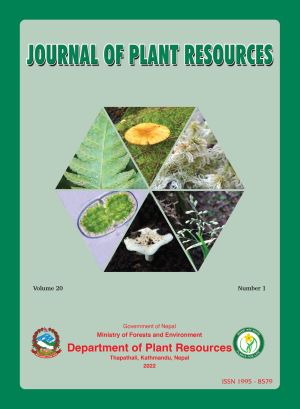Tree Species Diversity and Carbon Stock in Community and Religious Forests of Rupandehi, Nepal
DOI:
https://doi.org/10.3126/bdpr.v20i01.56581Keywords:
Aboveground biomass, Belowground biomass, Regression, Wood densityAbstract
Forest is one of the most important natural resources of the ecosystem which contributes in biodiversity conservation as well as plays a significant role in maintaining the earth’s climate by sequestrating atmospheric carbon. Tropical forests are rich in biodiversity and store large amounts of carbon. The studied Bolbum Community Forest (BCF) and Brahmakumari Global Religious Forest (BGRF) lie in tropical region between the altitudes 120 and 300 m asl in Rupandehi District of Nepal. The main objective of this research was to assess and compare tree diversities and carbon stocks in two different management regimes, namely, community forest and religious forest. Stratified random sampling technique was used for data collection. The allometric equation biomass-diameter regression (Model II) was used for estimation of carbon stock of tree species while Simpson and Shannon-Wiener indices were used to measure tree species diversity. The results showed that the carbon stock value was 27.15 t.ha-1 in BCF and 40.94 t.ha-1 in BGRF. The community forest had lower value of tree carbon stock than that of the religious forest. However, tree diversity was higher in BCF (25) than in BGRF (20). Shorea robusta was found to be the single dominant species in BGRF with higher basal area (102.24 m².ha-1) and contributed 56% of the carbon stock. The contribution of carbon stock of two co-dominant tree species in BCF were 32% for Shorea robusta and 26% for Terminalia anogeissiana. There was significant (p=0.05) positive relationship of carbon stock with basal area and DBH in both forest types.




